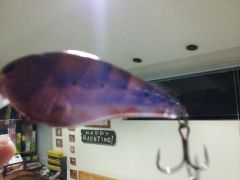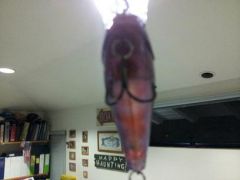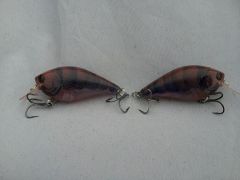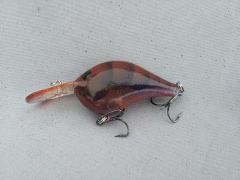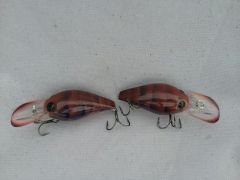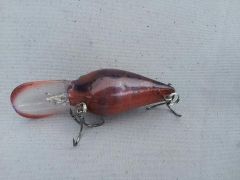-
Posts
14,726 -
Joined
-
Last visited
-
Days Won
364
Content Type
Profiles
Articles
TU Classifieds
Glossary
Website Links
Forums
Gallery
Store
Everything posted by mark poulson
-
-
-
I just checked. I will have to dip it one more time. I can still feel the foil joints. I could probably fish it like it is, but this is the first foiled bait I'm using the AC1315 on, so I want to really try and do everything to make it right, so I'll know how it works. I already know that one dip coat works on cranks,in terms of protecting the paint scheme, but I am shooting for smooth seams on this foiled bait. I'll dip it again tomorrow morning, and let you know how it comes out.
-
-
I will have to look. I never really noticed. I hate how lousy my pictures come out. The lures look so much better, at least to me. According to Nathan, the AC1315 is very high in solids, so it does have some body, but nowhere near an epoxy or Solarez. I just dipped a foiled lure this afternoon, so I can tell pretty soon if it has enough body to hide the seams, or if I need to dip it again. I'll let you know.
-
Woodie, I'm surprised you can't turn it. I would have thought a sharp tool, and gentle pressure, would work, but I haven't tried it myself. Have you tried using a belt sander to smooth the blanks while they're on the lathe?
-
-
-
Ted, Por Rok or Pour Stone are two readily available setting materials that have finer grit, and can be poured more easily. I used to use them both to set things like handrails in concrete. I found this Por Rok site: http://www.cgmbuildingproducts.com/prod4.htm I think the exterior material should work for you, but I've never tried it for lures.
-
Douglas, In my experience it is the moisture in the wood that causes the movement. Only really oily woods, like teak and the Malaysian hardwoods like Ipe now being sold, have enough oil in them to make them relatively stable. But the oils also make them heavy. The only other wood I've found that is really stable is balsa. I'm not sure why, but it doesn't seem to have enough residual moisture to make it move a lot, at least in smaller baits. I really have no idea why it is the way it is, but it is. Hahaha I tried all manner of sealers for my jointed wooden swimbaits (built from pine, douglas fir, poplar) and never found anything that worked except oil-based stuff. I learned to live with having to repair dents as they occurred. Then I found AZEK PVC decking and trimboard (thank you JR Hopkins) and my sealing worries were gone forever. It is hard, strong, waterproof, and buoyant. I can make a lure, put on the hardware, and test float it for ballasting without any sealer at all. I've even caught fish on unpainted lures I took up to my local pond for test swimming. Plus it can be shaped and carved with the same tools I used for wood. Amazing stuff!
-
I just posted some pictures of my first attempt at joint stenciling in the hardbaits gallery. They are all dipped once in AC1315, including the bills on the ones whose bills I painted. Here is a picture of the bait that wrinkled: http://www.tackleunderground.com/community/gallery/image/14033-wart-brown-purple-stenciled-wrinkled/
-
I let this bait come off my lure dip holder, and float in the AC1315 for an extra ten seconds before I reattached it and hung it to dry. The AC1315 topcoat wrinkled on the belly. I think it was too thick, and the surface flashed off and began to shrink before the underlying topcoat had off gassed it's solvent, so the finish crackled as it finally did completely off gas. I'm gonna fish it anyway!!!
-
My first attempt at stencils. These are Predator Baits knockoffs, cleaned with acetone before painting. They are all phantom schemes, so they are semi-transparent when held up to light. All are a med. brown back, lavender/deep blue mix stenciled joints, sparkle white/tran. orange belly. Createx and Wildlife paints, AC1315 topcoat, dipped one time.
-
My first attempt at stencils. These are Predator Baits knockoffs, cleaned with acetone before painting. They are all phantom schemes, so they are semi-transparent when held up to light. All are a med. brown back, lavender/deep blue mix stenciled joints, sparkle white/tran. orange belly. Createx and Wildlife paints, AC1315 topcoat, dipped one time.
-
My first attempt at stencils. These are Predator Baits knockoffs, cleaned with acetone before painting. They are all phantom schemes, so they are semi-transparent when held up to light. All are a med. brown back, lavender/deep blue mix stenciled joints, sparkle white/tran. orange belly. Createx and Wildlife paints, AC1315 topcoat, dipped one time.
-
That's debatable! My pleasure. I'm glad to be able to give something back to the site that has taught me so much.
-
Matt, I had no reaction between the crank and the plastic worm. On a side note, I dipped 5 lures yesterday. I leave them on a paper clip hanger to dip them and then hang them over the dipping jar to drip. One of them came off the hanger when I dipped, and I had to slip the hanger back into the line tie while the bait was floating in the AC1315. I went out to check on them this morning. That bait had some wrinkling on the belly, and some "crazing", almost crackling, on the back. The other 4 lures were fine. I think it was floating in the AC1315 too long, and it actually wound up with too thick a layer. It skins over really quickly, so I'm guessing the surface of the dip coat began to set before the solvents in the lower layer under it had off gassed completely, allowing the surface to pull on the still soft under coating. I plan not to let that happen again. I'll use a better hanger, and dip once and quickly in the future. It looks fine, otherwise. I'll do a test float today to see if the protection aspect of the top coat was compromised, and let you know.
-
I've tried most methods, and this works for me. For round eyes and kill spots, I use Ben's clear plastic method, and an airbrush. I can position the template better because it is clear, and it let's me make a truly round hole. I just have to wipe the template clean after each spot I shoot, so I can see and position the next one, and so no fresh paint sticks to my lure where I don't want it to. I use a solvent-based sharpie to touch up any imperfections if I need to. I used to make black eyes and spots with just the sharpie, but the template works so much better, and it comes out right every time.
-
There are lots of different types of epoxies out there. I hope this will help you to pick which type of epoxy will work best for you, not to recommend a particular brand. In my experience, there are two different types of epoxy that we use for lure coating, and they are different. One, like D2T, is, first and foremost, a glue. It is designed to fill small cracks between things, and to be very strong and rigid. Creep, which is movement over time of things that are attached, is a bad thing in a glue, where you want a joint that won't fail under load. But it is brittle when spread over a large, flat area, because it wasn't designed for that. The other type of epoxy we use is a decoupage epoxy, designed to cover large wooden surfaces, like table tops and bar counters. Etex is an example of a decoupage epoxy. It is designed to remain flexible, so it can move with the wood as it expands and contracts in reaction to temperature changes. When I first began building jointed lures, I tried using D2T as a top coat. What I found is that, because my baits had large flat sides, the D2T was very liable to crack if I hit anything like a rock or dock, and come off in large pieces. I switched to Etex, and never had that problem again. But the Etex did dent when I hit rocks, because it was not as rigid at the D2T. For smaller baits, like crank baits, and for more rounded surfaces, the D2T held up just fine. But for big, flat sided baits, Etex held up better. I think there are probably more threads on this forum about top coats than any other topic. We're all still searching for the holy grail, a perfect top coat that does it all, preferably with a built-in perfect paint scheme. I'll let you know when I find that one!
-
Ben, I am a bad person. My only comfort is that I know I won't be alone in the big hot seat down below. Hahaha Do you think they'll let us fish down there?
-
For fish with teeth, I'm guessing you want a wire leader. Since the baits sink at about 9" a second, and meant to sink, I don't think the wire would hurt the action. I tie directly to the line tie, but I'd probably use a split ring if I were putting on a wire leader. I'm speaking from my experience with the Duo Realis G-fix. They offer a version in sexy shad that works in low light, and off colored water. I don't know about other commercial baits. I caught several 2lb stripers, back to back, and they bent up the line tie/prop shaft, so I don't think these baits will hold up to heavier line and a stronger fight. That's the reason I made my own, so I could use heavier line and put on stouter hardware. When I lost a $14 store bought lure on 8lb test, that convinced me to find a way to use heavier line. I do count them down, both the G-fix and my own. They both sink at the same rate+-. I have let them go to the bottom in 35', and then retrieved them slowly along the bottom. It was a sandy mud bottom, with no snaggy stuff, so I could get away with it. I'm pretty sure any minnow eating predator will eat them. I've had channel cats eat jerk baits and cranks. I don't see why they wouldn't, and walleyes, too.
-
Thanks Bob. That makes sense. After breaking numerous bills on my Rapala cranks, I'm used to changing out broken bills, but I like to avoid it when I can. Why do I always think of Barbara Hershey whenever there is a lips thread?
-
I hope you used protection....on you trebles. Hahaha
-
The prop baits I used to fish, like the Devil's Horse, were top waters. The spybait is a sinking lure. The ones I fished, the Duo Realis G-fix 80, are basically a sinking jerk bait, with front and rear props. They weigh enough to be thrown with a baitcaster, sink level with a definate side to side wobble, and come back slightly nose up on a medium retrieve. They also wobble on the retrieve, so there is a lot of flash on a slow moving bait. The small props spin so fast they're hard to see, but they are described as adding additional water displacement and flash, too. I've had success throwing them over suspended fish, counting them down, and then bringing them back on a slow retrieve, on 10lb test. My friend throws his on 6lb, but my cojones aren't that big. I broke one off on 8lb, and, at $14 apiece, that can get expensive real quick! Hahaha
-
Really nice site. Good job, and good luck!




